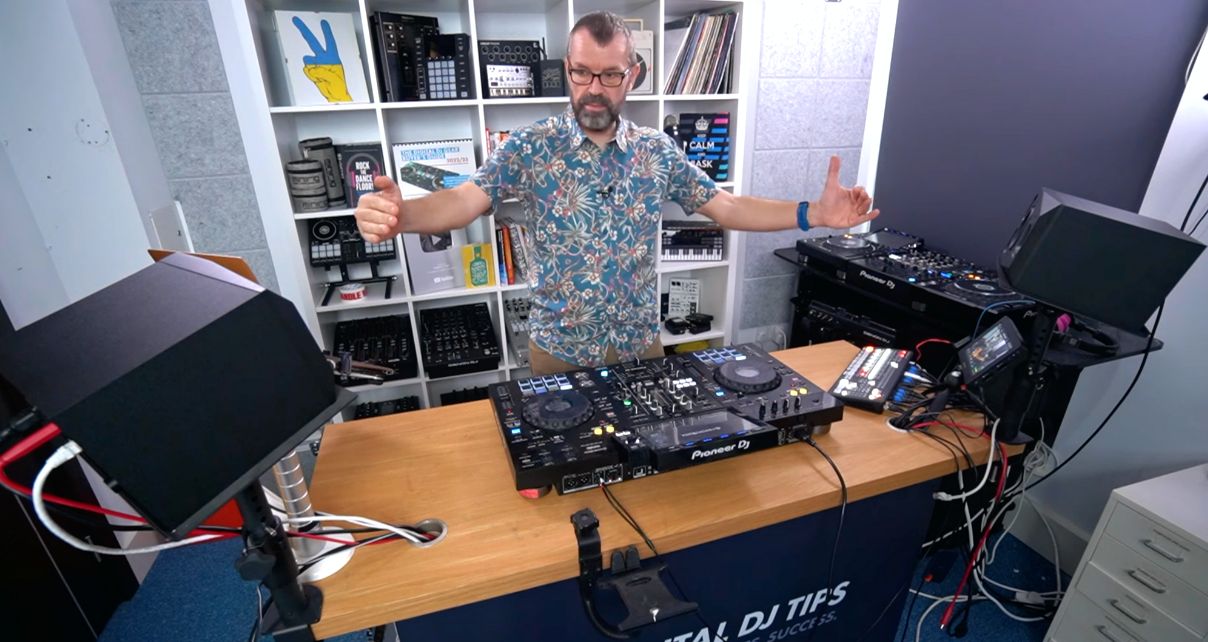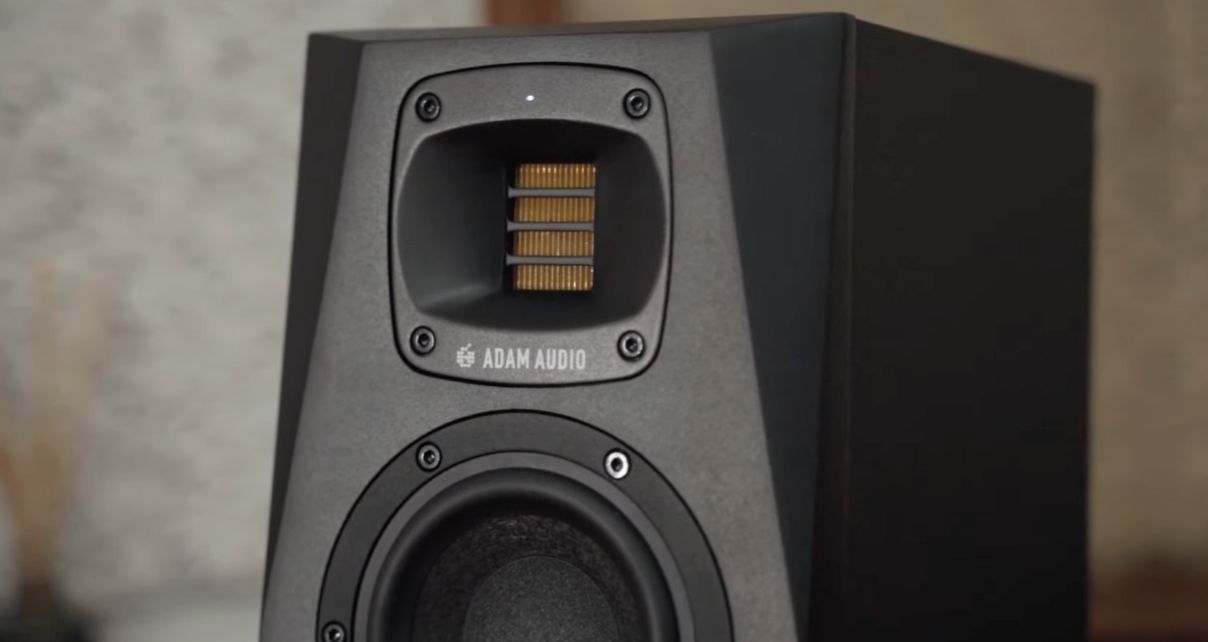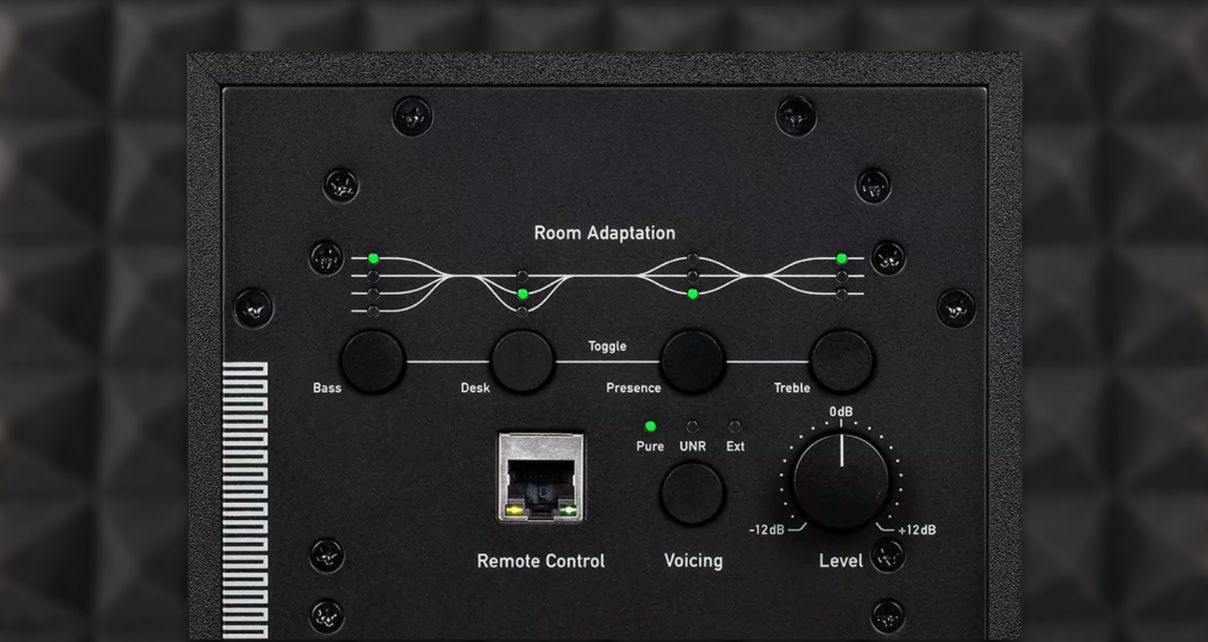The Lowdown
The Adam Audio A4V studio monitors are great sounding and flexible speakers for small studios. You can position them horizontally or vertically, they have screw mounts, and they have a built-in DSP for sonic fine-tuning. Paired with Adam Audio’s A Control Mac/Windows app, you can control them and customise the sound remotely. Uniquely, you can upload Sonarworks SoundID reference “filter sets” directly to them, to customise them 100% to your listening environment. If such features appeal to you, the A4Vs are worth the extra money over more basic monitors.
Don’t have our 2023 DJ Gear Guide? Click here to grab your free copy
Video Review
First Impressions / Setting up
The Adam Audio A4V is part of a full set of new speakers from Adam Audio, replacing the AX series. Here we’re considering the smallest model, the A4V. They’d be a good choice for smaller studio spaces and DJ practice rooms, and as such they’re actually a good match for our small studio here at Digital DJ Tips, where we’ve been testing them. They’re single, powered speakers (class D for bass and class AB for woofer and tweeter respectively), and of course most people would buy two to make a stereo pair.

Before we even look at these, an important point to make is that positioning is everything with speakers. You want the tweeters at ear level (or at least pointing at your ears), and of course you want the speakers equidistant from your listening position. Just by experimenting with positioning, you can radically alter the sound of any speakers. In our studio, we have our monitors on speaker mounts and angled slightly up, so they’re “aimed” at our ears when DJing. It makes a world of difference.
Read this next: 5 Tips For A Great-Sounding DJ/Producer Home Studio
Anyway, these are called the A4V because they have 4″ woofers – small, in other words. While KRK’s speakers, for instance, are instantly recognisable by their yellow cones, Adam Audio’s are nearly as iconic for their unusual-looking rectangular folded ribbon tweeters, which they call X-ART. These can be unscrewed easily and rotated 90 degrees so the dispersion happens correctly, even if you’ve got the speakers positioned (as we do) horizontally – a nice touch.

The front of the speakers also feature two ports for bass dispersion, and a small LED in the tweeter mount, which shows you that the speaker is powered up, plus various other things. On the bottom are four mounting screw threads. The build material is vinyl-wrapped MDF, with painted MDF front panels.
Round the back are an IEC socket for power plus its on/off switch, inputs for XLR balanced and RCA unbalanced with a selector button, four “room adaption” buttons that can tweak bass, low mid, high mid and treble slightly to suit your positioning and environment, and a level knob that lets you reduce or boost volume by 12dB. There’s also a “voicing” button and a “remote control” Ethernet socket – we’ll get to those in a second.
For just getting set up and going, though, you attach a source, turn everything down, switch on, set the input selector, turn your source slowly up to a decent volume, and you’re off.
In Use
Using the DSP
Of course, with all those DSP controls around the back, you’re going to want to do some tweaking. At this stage you’ll want to have a play with the four “room adaptation” buttons. First though, you’ll need to decide where to set the “Voicing”. Your choices are “Pure”, “UNR” and “Ext”. Pure is the purest audio, while UNR has the DSP reproduce the sound of older Adam Audio speakers, especially the previous AX range. Finally, Ext is for external control, which we’ll cover shortly.

The room adaptation buttons let you boost or reduce the four frequencies covered, from bass to treble. They’re fine tuning, nothing more, and the main one you’ll probably want to use is the bass control, to reduce the bass in very small rooms, or when the speakers are in corners or close to a wall. These settings do make a noticeable difference, so it’s worth experimenting.
The sound
Bearing in mind that this is a 4″ woofer monitor, the sound is excellent. We liked using the “Pure” voicing for production, and the “UNR” voicing for DJing, finding the latter to be a bit fuller in the mid-range, and more lively. We didn’t feel the need to roll the bass off as we thought we might, probably due to our speaker positioning being dead centre in our room. Some reviewers spoke of a slight brightness, but we felt in the “Pure” setting that wasn’t audible.
While you’re not going to get sub bass out of these due to their size, equally we feel you won’t miss a sub-woofer. They’re distortion-free up to way past the volume we’d dare to play them at, and that – combined with the fact that the frequency response is flat enough even at the lower end of its tech spec (they go down to 58Hz) – means they sound wonderfully full. Frankly, for DJs, they’re engaging and a lot of fun when you pump them up.
Learn to DJ with us: The Complete DJ Course
The manufacturer recommends you “run them in” for eight hours to let them settle down, and we predict you’ll have a lot of fun doing so.
The A Control app
So here’s where it gets interesting. Adam Audio has an app called A Control, which lets you control the speakers “remotely”. It is for Mac and Windows, and you need to connect both your computer and your speakers to an Ethernet network to use it. Once you have, the speakers appear in the A Control app, and you can control everything we just described remotely, ie from the laptop.

This is useful because it means you can potentially make the fine-tuning adjustments from your listening position, rather than having to lean behind the speakers to do so. It also means that you can access a higher level of control. There’s a full six-band EQ with shelves, delay, Q adjustment and other advanced DSP settings, so you can get super-granular. You can save favourite settings, too.
Were you to start adding extra speakers from the range (for instance to make a Dolby Atmos system in your studio), you’d definitely benefit from this extra level of system control. But for DJ/producers with just a stereo pair, it’s an awful lot of faff to save you nipping behind the speakers when initially setting them up to make adjustments. It would be neat if it were a phone app, and if the speakers could communicate via Bluetooth or Wifi with that app, Sonos Trueplay style.
Sonarworks SoundID Reference filter set integration
Sonarworks is a third-party company that makes a computer app called SoundID Reference, designed to help those who deeply care about audio quality to eliminate sound colouration caused by their headphones, or speakers/room.
Read this next: Sonarworks SoundID Reference For Headphones Review
When it comes to speakers, you purchase a measurement microphone from Sonarworks, sample the audio from your listening position in your studio, and then Sonarworks SoundID Reference will compensate for imperfections in your room and speakers, giving you better and custom sound.

But you do need to have their app running on your laptop and your audio routed through it for it to apply the “filter set” – which takes resources, adds complication, and is hard if not impossible to set up when using external audio gear like DJ kit.
So here’s the clever bit: With the A series of monitors, once you’ve done the set-up, you can upload your Sonarworks filter set directly to your speakers, so they apply the corrections to all audio permanently – no laptop, software or special audio routing required. It’s super neat, and no other speakers to our knowledge have this currently.
Conclusion
The Adam Audio A4V are well built, reassuringly sombre and weighty, and have thoughtful touches – we particularly liked the option for screw-mounting them, and the ability to rotate the tweeter so the dispersion cone makes sense when the speakers are horizontal.
As they’re part of a larger range and are not Adam Audio’s entry-level monitors, using a pair of them in a small home studio does put you at the bottom end of the target user base. Some of the features, such as fine-tuning and remote control via Ethernet using the A Control app, or uploading Sonarworks filter sets to them, are arguably more suited to professional use and multi-speaker systems in studios, and you may regard these as overkill. In that case, Adam Audio has its simpler, cheaper F Series of monitors that may be a better choice for you.

Want help choosing gear? Grab your free PDF: The Digital DJ Gear Buyer’s Guide
Likewise, if you like the customisation idea but not the complexity of the A Series approach, you may want to consider the IK Multimedia iLoud MTM speakers, which come with a microphone you can use to auto calibrate to your listening position in your studio, with no need for Ethernet, extra apps, or third-party software. (We’ve yet to review them at the time of writing, though – watch this space.)
However, forgetting the bells and whistles for a second – a speaker has to sound good. These do. They’re loud, for practical purposes distortion-free, and can easily be fine-tuned for your room, listening position, and personal preference, right out of the box. They’re a more than decent speaker as they are, and so if they’re in your budget range, you should seriously consider them – we think you’d find them close to perfect as a small pair of DJ/producer home studio monitors.




